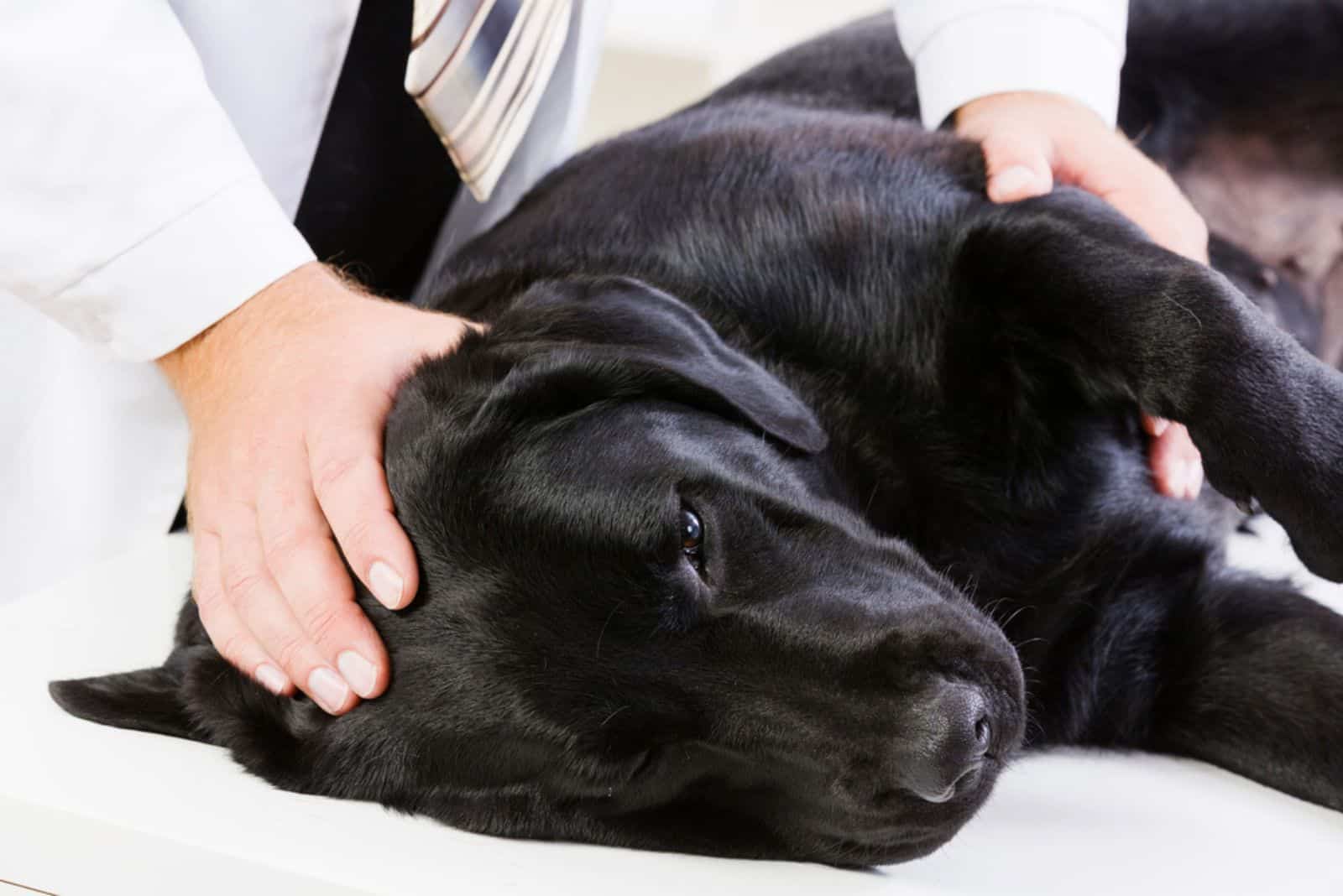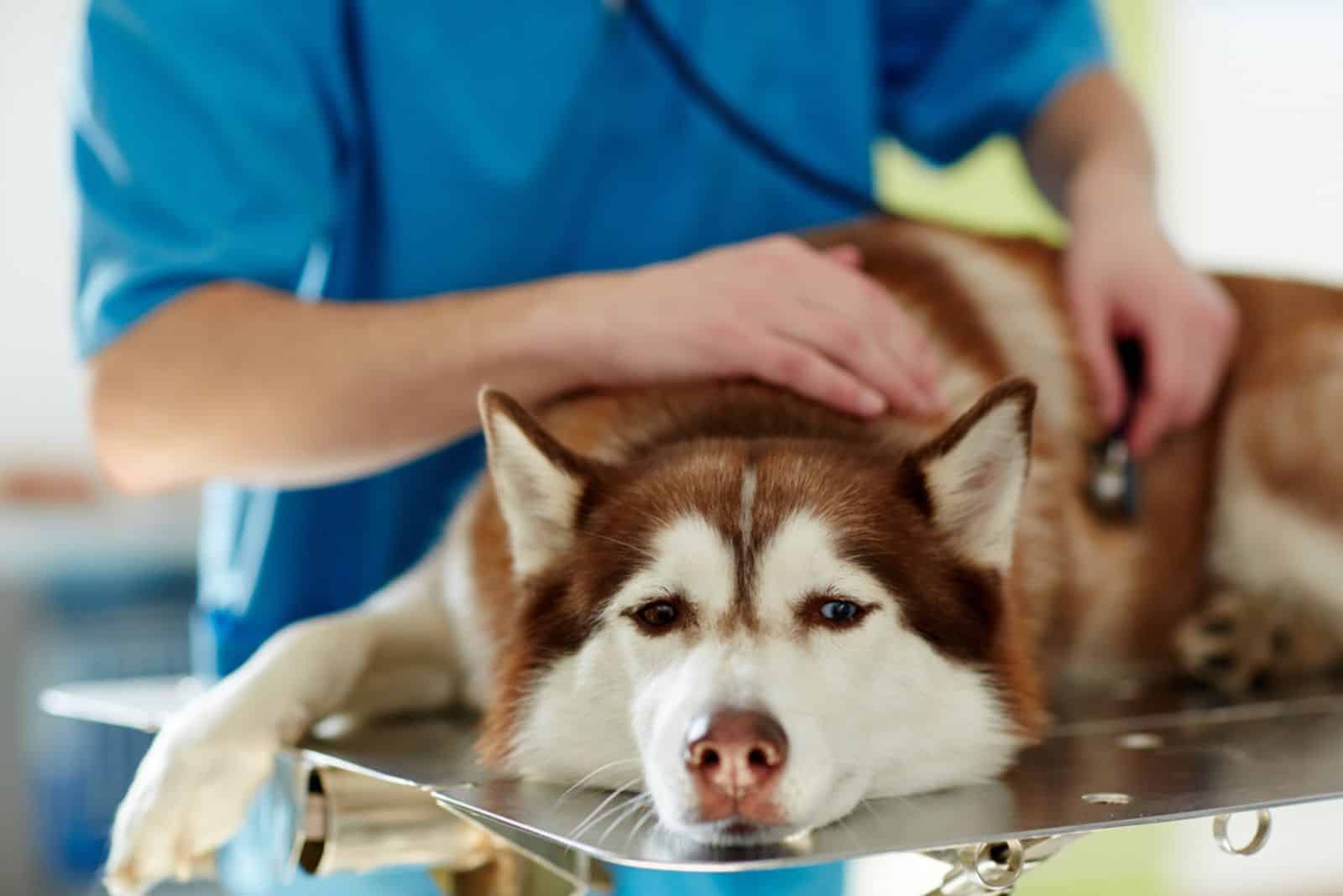This is the hardest thing to talk about, let alone do. The decision that it’s time to say goodbye to your doggo for the last time is heartbreaking.
There is no easy way through it. A dog that has canine kidney disease will eventually come to the last stage of the disease. And, when it comes to that, we have to say: OK, it is a dog kidney failure – when to euthanize?
All of the decisions about euthanasia should be made by a licensed veterinarian. The vet will examine your pet, follow it through to the last stage and decide when it is time to do the hardest thing.
I will walk you through the signs that tell us the time has come to do the inevitable. It is not an easy thing to witness.
But it is important to know that you are doing this to stop your doggo from suffering. Your dog won’t feel any kind of discomfort during the process of euthanasia. You are preventing a painful death. You are giving your dog a peaceful transition.
Dog Kidney Failure – When To Euthanize?

I know it is not easy to agree and sign the papers giving your vet the green light to euthanize your dog. I’ve been there, and words cannot express the difficulty of such a decision. But keep in mind that you are helping your doggo for one last time.
If it’s any consolation — whether you believe all dogs have a soul or that all dogs go to heaven, they are going to a better place. It is a place without pain and suffering. Another universe, another energy form, or real doggy heaven — whatever you believe, it all comes to the same: no pain.
The thought that looms over us: ‘dog kidney failure, when to euthanize?’ is a serious decision that should always be approved and done by a certified DVM (doctor of veterinary medicine). It is not something you should be going through alone.
You want to fight till the end for your furry (best) friend, but there will come a time when your vet will tell you to do the right thing. When is the right time?
Let’s see what we should pay attention to and what the vets pay attention to when it comes to canine kidney failure or chronic renal failure.
When To Say Goodbye?
First of all, the kidney disease in dogs that we are talking about here is the inability of a dog’s kidneys to clean the blood from various toxins, not their inability to produce urine. We are talking about chronic or acute kidney failure.
It is one of the most difficult diseases in dogs, just like dog liver failure, and it’s upsetting and agonizing to watch our doggos in such conditions.
The outcome of both versions of this kidney disease and the question that comes after them is the same: it’s a dog kidney failure — when to euthanize?
When you get medical advice that the best option is to put your dog down, that means your dog has reached end-stage kidney failure. Simply put, there is nothing else that could be done to help improve your dog’s quality of life.
What Are The End Stage Symptoms?

In both acute and chronic kidney disease, the advanced stages are the same. In the end, the elimination of the toxic waste via the kidneys and urine completely stops. That means that the toxins start to build up in the body.
For a dog owner or any pet owner, these final stages can be very traumatic and devastating, especially when we watch our furry friends wither in front of our eyes.
Here are the symptoms to expect in the last days of your dog that has kidney problems.
1. Complete Loss Of Appetite
A dog in the end stage will completely refuse to eat, and it will also refuse to drink water. He will have no desire or strength to move to eat something.
His body is shutting down, and by now, the loss of appetite makes a circulus vitiosus pattern in which a situation with no food leads to lack of strength, lack of strength leads to loss of appetite, and round it goes in a circle.
The dog’s body is shutting down, and it can’t take any food or water no matter how much we try to give our doggo some food.
2. Lack Of Strength
When a dog is dehydrated, has a loss of appetite, and is in pain — it won’t have the strength to do normal daily activities. They will be slow, and they will spend more time sleeping. You will notice your dog doesn’t want to play anymore and is generally looking tired all the time.
Lethargy is a sign of many diseases, but as mentioned, when combined with other symptoms, it can also mean kidney failure disease.
You can check your dog’s general posture and behavior, too. What is your dog’s tail position, where and how long it sleeps, does it act weird all of a sudden and then lethargic, and are there any other things you can notice?
In the final stages, the lethargy turns into a complete lack of strength. There are too many toxins in the bloodstream, poisoning the body from the inside. There is no water and no food, which means there is no usable energy.
A dog might just wag his tail a bit just for you and because of the love he feels for you, even in these last days.
3. Urine And Bowel Incontinence
A dog that has reached the end stage of kidney disease won’t be able to control urination and defecation. In other words, they will suffer from bowel and urine incontinence. These are the final stages.
Your dog cannot control the sphincters that are responsible for keeping it all in until the brain gives the green light for it all to go. Meaning urinating and defecating are controlled by the brain until the brain gets damaged by the toxins so that it cannot do its job anymore.
Bowel incontinence is not that present because of a lack of food in the digestive system. But because of the abnormal kidney function — urine incontinence is much more present.
4. Bradycardia
In the beginning, when the kidney problems have just started, a dog will have tachycardia — a faster heart rate. But, in the end, the heart will start to slow down to bradycardia — a low heart rate. That is another sign of the last stage.
In the beginning, the heart pumps blood faster to help the body get rid of the waste material from the bloodstream. But, in the end, the heart also gets “flooded” with toxins and it cannot fight against them anymore.
As a result, the heart pumps the blood slower and slower until it reaches the critical level when the pulse is barely palpable.
5. Constant Pain
Another sign of the end stage is constant pain. There are no medications to stop the pain or alleviate it.
It’s chaos inside your dog’s body where toxins ruin the balance and damage the cells causing immense pain. Your vet will be able to ease the pain in the beginning, but as the final stage gets closer, there won’t be anything your vet can do for your doggo.
6. Problems With Balance
In the end stage, you will notice that your dog has problems with balance — it starts to wobble, seems disoriented, falls, is insecure while walking, or has similar difficulties; it is definitely the time to start preparing for the inevitable.
Problems with balance start because of the imbalance of the electrolytes in your dog’s body as a result of the accumulated toxic waste in its blood.
You will see your dog looks confused, desperately trying to do something, but his body won’t let him do it. Keeping your dog on ground level and safe from sharp objects is important in this part of the final stages.
7. Seizures
One of the symptoms of the final stages of canine renal failure is seizures. These seizures start as shakes and trembles. The occasional shakes turn into more frequent trembles, which eventually lead to convulsive seizures.
They come from the accumulation of toxic materials in the bloodstream. It is a difficult thing to witness. The only thing you can do when you witness something like this is to take your dog to the vet. The vet can do some blood work and see what might be the problem.
These symptoms can mean your dog has signs of diabetes, as well. As a matter of fact, one of the outcomes of untreated diabetes in dogs is renal failure.
In either case, your veterinarian can examine your dog, do necessary blood work and make the proper diagnosis.
What Are Some Other Symptoms?

When a dog has a problem with its kidneys, the early-stage symptoms won’t be as obvious, especially if it’s chronic renal failure.
You will notice your dog urinates more often, and you will also notice your dog drinks water more than usual. At first, we won’t think this is anything alarming. These are just common symptoms that can occur in various diseases. And, it might not be alarming. But we should pay attention to our dog’s behavior in the upcoming days.
Let’s see what the early symptoms of kidney disease are before we get to the bottom of the question: a dog kidney failure – when to euthanize?
1. Increased Water Intake
This is one of the first signs we will notice. This sign and frequent urination. The reason behind this symptom is the fact that your dog’s kidneys are slowly starting to “shut down”. They are not working properly.
The blood that’s supposed to be cleaned and the waste turned into urine just flows through the kidneys without any efficient cleaning being done. This disturbs the balance of the electrolytes in the dog’s body which leads to other symptoms.
2. Decreased Appetite
A dog won’t have much interest in food. Besides the nausea they might feel, which can consequently lead to vomiting, mouth ulcers, and dry mouth can also be reasons why dogs refuse food.
The decreased appetite leads to weight loss. The loss is rapid and quite noticeable. By now, we have started to wonder what is wrong with our doggo. No matter what food we put in front of him, our dog looks like it wants to, but can’t eat.
3. Pale Gums
One of the first things a vet does when he or she wants to examine a pet, whether it’s a dog or a cat, they check its gums. The color, shape, and sensitivity of the gums (gingiva) can often tell us there is something wrong with the pet.
During renal failure, a dog will have pale and dry gums. The dog is dehydrated, and it shows on the gums and the dog’s skin. When the vet pulls a little bit of skin between the dog’s shoulder blades, the skin stays “pulled” for a while. In normal circumstances, It should snap right back.
The normal color of the dog’s gums is salmon pink. If the gums are white — there is a “fight” happening in the dog’s body . It might be an infection, high body temperature, or dehydration.
4. Red Eyes
The whites of your dog’s eyes will turn red as one of the symptoms of renal failure. This is still an early stage of the disease, and the question we’ve been talking about: a dog kidney failure when to euthanize, is not yet on the table.
But, it is one of the symptoms that your dog’s body is in distress. There is a problem happening, and because doggos can’t tell us what’s wrong, it is our responsibility to notice these signs and take the dog to the nearby animal hospital.
5. Mouth Ulcers
This is not only a symptom of renal failure. Just like other symptoms we mentioned, they can mean something else. But, when combined — they tell us something is wrong, and they tell the veterinarian where to look to find the answer.
Mouth ulcers happen because the oral mucosa is dry and prone to breaking. A broken gingiva is a perfect place for the development of a bacterial infection that can cause the ulcers we mentioned. These ulcers are also very painful.
Because of dehydration, there is not a lot of saliva in the oral cavity to moisturize the gums. This is another reason for bacterial infections.
Accepting The Truth
Even when you notice some of these signs and your vet confirms the other signs, you will still have the urge to ask a vet if there is anything else to do. I understand that, and it is a normal reaction when we love someone. We fight for their lives.
You might not even believe what the vet says. But, no matter if your veterinarian has years of experience or they just started their practice, the blood test results tell us the harsh truth, and the test results are, unfortunately, not wrong.
The blood tests will show all the damage done by waste products and how irreversible it is. This is the time to say the hardest words: do it.
How Does Kidney Failure Happen?

Most of the time, kidney failure in dogs happens with age. It is like the kidney function wears off. The kidneys do not have the power of regeneration as the liver does.
So, when the degradation of the kidney cells starts to happen, there are no new ones to “fill in the gaps”. The kidneys will continue to deteriorate until they cannot filter the blood anymore, and the waste products eventually end the dog’s life.
Poisoning can lead to kidney failure too. The most common chemical or toxin dogs ingest is antifreeze. Other times a bacterial infection, if left untreated, can cause the failure of the kidneys. And, of course, it can be idiopathic — the reason unknown.
The most common reasons for dog kidney failure to happen are:
- Age
- Poisoning
- Bacterial infection (Leptospirosis, Pyelonephritis, etc.)
- Idiopathic (unknown)
The poisoning and bacterial infections will usually cause acute renal failure in dogs, while age and idiopathic renal failure often start slow and take time to fully develop — sometimes even years.
How Is Dog Kidney Failure Diagnosed?

We can notice the symptoms we talked about, but these symptoms can mean a lot of things. They can definitely tell us something is wrong with our furry friend, but we won’t be sure what the problem is until the vet examines the dog.
There are two ways to evaluate renal function and diagnose the dog’s kidney failure:
- Blood analysis
- Urine analysis
When the tests show the dog has kidney failure, there are other steps to determine the stage of the failure. This is also done by a veterinarian. They can use the IRIS staging system.
This system can tell them about the level of proteins in the bloodstream, which is an indication that the kidneys are not working properly. The number of proteins and creatinine in the bloodstream tells us the stage of kidney failure.
What Next?
After the clinical examination and related post examination of the blood work and urine analysis, the vet can see if the dog has a high number of proteins in the blood, anemia, elevated blood pressure, and other signs that point to kidney disease.
Depending on the stage of the kidney failure, the vet can prescribe:
- High blood pressure medication
- Low sodium and phosphorus diet
- Supplements
- Administration of subcutaneous fluids
You can also try to make life as comfortable as possible for your doggo in his final days. Keep it clean, dry, and warm. They won’t be able to control their urine or defecation, so keeping them clean and dry is very important.
Answering the question of dog kidney failure: when to euthanize is devastating. You can always search for more answers for informational purposes, but the final and main word has to come from your veterinarian.
The Conclusion
There is not a lot I can say to comfort you if you have to read about the topic — dog kidney failure: when to euthanize. But the only thing that matters in this situation is that you have to know that you are doing this for your dog.
Your dog is in pain and suffering from a disease from which it cannot recover. Your dog will experience seizures, pain, and even difficulty breathing. They won’t be able to walk or control their bladder.
It is not a life — it is agony. Don’t worry, I know you are going to fight till the end! You will try everything, call every doctor, check every medication and give it to your doggo, and you will hold its paw and say for a thousand times what a good boy he is.
But, eventually, when it comes to kidney failure — you will have to let go. There are places in the US where you can euthanize your dog for free. Or you can arrange it at your local veterinary ambulance or animal hospital.
Whatever you choose, stay brave and strong, and remember that your doggo is in a better place now.













